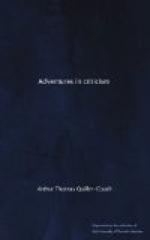A good story and real life are such that, being produced in either direction and to any extent, they never meet. The distance between the parallels does not count: or rather, it is just a matter for the author to choose. It is here that Mr. Howells makes his mistake, who speaks contemptuously of Romance as Puss in Boots. Puss in Boots is a masterpiece in its way, and in its way just as true to life—i.e., to its distance from life—as that very different masterpiece Silas Lapham. When Mr. Howells objects to the figure of Vautrin in Le Pere Goriot, he criticizes well: Vautrin in that tale is out of drawing and therefore monstrous. But to bring a similar objection against Porthos in Le Vicomte de Bragelonne would be very bad criticism; for it would ignore all the postulates of the story. In real life Vautrin and Porthos would be equally monstrous: in the stories Vautrin is monstrous and Porthos is not.
But though the distance from real life at which an author conducts his tale is just a matter for his own choice, it usually happens to him after a while, either from taste or habit, to choose a particular distance and stick to it, or near it, henceforth in all his writings. Thus Scott has his own distance, and Jane Austen hers. Balzac, Hugo, Charlotte Bronte, Dickens, Tolstoi, Mr. Howells himself—all these have their favorite distances, and all are different and cannot be confused. But a young writer usually starts in some uncertainty on this point. He has to find his range, and will quite likely lead off with a miss or a ricochet, as Mr. Hardy led off with Desperate Remedies before finding the target with Under the Greenwood Tree. Now Mr. Hope—the application of these profound remarks is coming at last—being a young writer, hovers in choice between two ranges. He has found the target with both, and cannot make up his mind between them: and I for one hope he will keep up his practice at both: for his experiments are most interesting, and in the course of them he is giving us capital books. Of the two before me, The God in the Car belongs to the same class as his earliest work—his Father Stafford, for instance, a novel that did not win one-tenth of the notice it deserved. It is practice at short range. It moves very close to real life. Real people, of course, do not converse as briskly and wittily as do Mr. Hope’s characters: but these have nothing of the impossible in them, and even in the whole business of Omofaga there is nothing more fantastic than its delightful name. The book is genuinely tragic; but the tragedy lies rather in what the reader is left to imagine than in what actually occurs upon the stage. That it never comes to a more explicit and vulgar issue stands not so much to the credit of the heroine (as I suppose we must call Mrs. Dennison) as to the force of circumstances as manipulated in the tactful grasp of Mr. Hope. Nor is it to be




